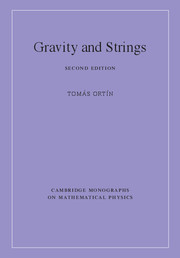Book contents
- Frontmatter
- Dedication
- Contents
- Preface to the second edition
- Preface to the first edition
- Part I Introduction to gravity and supergravity
- 1 Differential geometry
- 2 Symmetries and Noether's theorems
- 3 A perturbative introduction to general relativity
- 4 Action principles for gravity
- 5 Pure N = 1, 2, d = 4 supergravities
- 6 Matter-coupled N = 1, d = 4 supergravity
- 7 Matter-coupled N = 2, d = 4 supergravity
- 8 A generic description of all the N ≥ 2, d = 4 SUEGRAs
- 9 Matter-coupled N = 1, d = 5 supergravity
- 10 Conserved charges in general relativity
- Part II Gravitating Point-Particles
- Part III Gravitating extended objects of string theory
- Appendix A Lie groups, symmetric spaces, and Yang–Mills fields
- Appendix B The irreducible, non-symmetric Riemannian spaces of special holonomy
- Appendix C Miscellanea on the symplectic group
- Appendix D Gamma matrices and spinors
- Appendix E Kähler geometry
- Appendix F Special Kähler geometry
- Appendix G Quaternionic-Kähler geometry
- Appendix H Real special geometry
- Appendix I The generic scalar manifolds of N ≥ 2, d = 4 SUEGRAs
- Appendix J Gauging isometries of non-linear σ-models
- Appendix K n-spheres
- Appendix L Palatini's identity
- Appendix M Conformal rescalings
- Appendix N Connections and curvature components
- Appendix O The harmonic operator on ℝ3 × S1
- References
- Index
6 - Matter-coupled N = 1, d = 4 supergravity
from Part I - Introduction to gravity and supergravity
Published online by Cambridge University Press: 05 April 2015
- Frontmatter
- Dedication
- Contents
- Preface to the second edition
- Preface to the first edition
- Part I Introduction to gravity and supergravity
- 1 Differential geometry
- 2 Symmetries and Noether's theorems
- 3 A perturbative introduction to general relativity
- 4 Action principles for gravity
- 5 Pure N = 1, 2, d = 4 supergravities
- 6 Matter-coupled N = 1, d = 4 supergravity
- 7 Matter-coupled N = 2, d = 4 supergravity
- 8 A generic description of all the N ≥ 2, d = 4 SUEGRAs
- 9 Matter-coupled N = 1, d = 5 supergravity
- 10 Conserved charges in general relativity
- Part II Gravitating Point-Particles
- Part III Gravitating extended objects of string theory
- Appendix A Lie groups, symmetric spaces, and Yang–Mills fields
- Appendix B The irreducible, non-symmetric Riemannian spaces of special holonomy
- Appendix C Miscellanea on the symplectic group
- Appendix D Gamma matrices and spinors
- Appendix E Kähler geometry
- Appendix F Special Kähler geometry
- Appendix G Quaternionic-Kähler geometry
- Appendix H Real special geometry
- Appendix I The generic scalar manifolds of N ≥ 2, d = 4 SUEGRAs
- Appendix J Gauging isometries of non-linear σ-models
- Appendix K n-spheres
- Appendix L Palatini's identity
- Appendix M Conformal rescalings
- Appendix N Connections and curvature components
- Appendix O The harmonic operator on ℝ3 × S1
- References
- Index
Summary
Just as the simplest extension of general relativity that respects its general covariance consists in its coupling to general-covariant matter fields (that is, tensor or spinor fields), the simplest way to extend a supergravity theory respecting its invariance under local supersymmetry transformation is by coupling it to supersymmetric matter fields, that is, matter fields that form complete supermultiplets that transform irreducibly under supersymmetry. The matter-coupled theory can then be deformed by gauging its global symmetries, for instance. The supergravities that arise as effective string theories contain in general matter and gauged symmetries and, moreover, any potential application to real- world phenomenology would require these ingredients.
In this chapter we are going to study the general coupling of supersymmetric matter to the pure, ungauged, N = 1 supergravity theory that we constructed in Chapter 5 and the gauging of its global symmetries. Our goal will be to write the most general bosonic action of N = 1, d = 4 supergravity and its supersymmetry transformation rules for vanishing fermions in full detail. By bosonic action we mean the action that results from setting to zero all the fermionic fields. This is always a consistent truncation: all the solutions of the equations of motion of the bosonic action are automatically solutions of the equations of motion of the complete action with all the fermions set to zero. We are interested in bosonic field configurations that represent the long-range fields of black holes, waves, etc., and, therefore, we only need to know the bosonic action. We will need the supersymmetry transformation rules of all the fields with the fermions set to zero to study the unbroken supersymmetry of the bosonic solutions, a concept that will be explained in Chapter 17.
A much more rigorous treatment of the coupling of supergravity to supersymmetric matter can be found in the classic literature and also in the recent book [564].
- Type
- Chapter
- Information
- Gravity and Strings , pp. 199 - 219Publisher: Cambridge University PressPrint publication year: 2015



